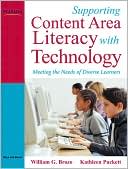List Books » Supporting Content Area Literacy with Technology: Meeting the Needs of Diverse Learners
Category Books
- Fiction Books & Literature
- Graphic Novels
- Horror
- Mystery & Crime
- Poetry
- Romance Books
- Science Fiction & Fantasy
- Thrillers
- Westerns
- Ages 0-2
- Ages 3-5
- Ages 6-8
- Ages 9-12
- Teens
- Children's Books
- African Americans
- Antiques & Collectibles
- Art, Architecture & Photography
- Bibles & Bible Studies
- Biography
- Business Books
- Christianity
- Computer Books & Technology Books
- Cookbooks, Food & Wine
- Crafts & Hobbies Books
- Education & Teaching
- Engineering
- Entertainment
- Foreign Languages
- Game Books
- Gay & Lesbian
- Health Books, Diet & Fitness Books
- History
- Home & Garden
- Humor Books
- Judaism & Judaica
- Law
- Medical Books
- New Age & Spirituality
- Nonfiction
- Parenting & Family
- Pets
- Philosophy
- Political Books & Current Events Books
- Psychology & Psychotherapy
- Reference
- Religion Books
- Science & Nature
- Self Improvement
- Sex & Relationships
- Social Sciences
- Sports & Adventure
- Study Guides & Test Prep
- Travel
- True Crime
- Weddings
- Women's Studies
Supporting Content Area Literacy with Technology: Meeting the Needs of Diverse Learners » (1st Edition)

Authors: William G. Brozo, Kathleen G. Puckett
ISBN-13: 9780205511853, ISBN-10: 0205511856
Format: Paperback
Publisher: Allyn & Bacon, Inc.
Date Published: August 2008
Edition: 1st Edition
Author Biography: William G. Brozo
Kathleen Puckett has thirty seven years experience as a teacher, administrator, and teacher educator in special education. She co-authored (with Blanche O’Bannon) Preparing to Use Technology: A Practical Guide to Curriculum Integration (Pearson) which takes the perspective that readily available technology can assist all students in achieving their learning goals.
William G. Brozo is a literacy scholar and teacher with numerous articles and books on reading, including Content Literacy for Today’s Adolescents: Honoring Diversity and Building Competence and 50 Content Area Strategies for Adolescent Literacy (both of Pearson). Bill is also co-author of the The Reading Teacher column, “Content Literacy” and columnist of “Strategic Moves” for the international journal, Thinking Classroom. He is a national and international literacy consultant and professional developer.
Book Synopsis
To make content area learning more engaging and meaningful for all students Kathy and Bill present teachers with a basic framework for pairing literacy strategies with readily available classroom technology. Drawing on concepts of universal design, and flexible curriculum access, the authors explore legislation authorizing the use of technology for learners with diverse abilities and offer teachers tools to make technology work in their classroom. Their evidence-based procedures, explicit instruction strategies, and authentic activities guide teachers in integrating curriculum with English/language arts, social studies, science, and math to reduce the barriers to learning and improve student achievement. Kathy and Bill’s friendly advice and suggestions for technology adaptations for reading strategies are the just the support teachers need to turn their classroom into a powerful learning community that fosters reading comprehension and content learning for all students.
Learn how to use technologyas a tool for providing literacy strategy supports with Supporting Content Area Literacy with Technology!
- Demonstrates how instructional technology can become the media for teaching and learning literacy strategies in all subject areas.
- Helps teachers to plan flexible strategies to meet a wide range of student abilities with explicit instruction examples.
- Guides teachers in developing skills in both content area teaching and effective use of instructional and assistive technology.
- Provides teachers of subject areas tools for meeting the content learning needs of all students.
- Focuses attention on the importance of helping all students, including those with disabilities, meet content standards .
- Takes advantage of the interactive nature of instructional technology for motivating students to become more engaged and thoughtful learners.
- Features "Questions of Study" to aide facilitators in further discussion and learning for book club study groups.
- Presents classroom examples of content literacy and technology within a content area (Social Studies, Language Arts, Science, and Math); including sample text, application of content strategies for readiness, interactive comprehension, and extending new learning with a technology example derived from the sample text.
Table of Contents
Ch. 1 Content Literacy and Technology: A Twenty-First-Century Approach for Children with Diverse Abilities 1
Ch. 2 Content Literacy and Learning Strategies 22
Ch. 3 Designing Lessons to Meet a Wide Range of Abilities 69
Ch. 4 Social Studies: Content Literacy and Technology 87
Ch. 5 Language Arts: Content Literacy and Technology 111
Ch. 6 Science: Content Literacy and Technology 137
Ch. 7 Math: Content Literacy and Technology 158
Ch. 8 Technology Tools for Content Literacy Support 178
Index 221
Subjects
 WWW & Internet
WWW & Internet  Education Online
Education OnlineEducation & Teaching
 Teaching & Teacher Training
Teaching & Teacher Training  Computers & Technology in Education
Computers & Technology in EducationEducation & Teaching
 Teaching & Teacher Training
Teaching & Teacher Training  Educational Aspects of Technology
Educational Aspects of TechnologyEducation & Teaching
 Teaching & Teacher Training
Teaching & Teacher Training  Teaching Aids & Devices
Teaching Aids & DevicesEngineering
 Social & Cultural Aspects of Technology
Social & Cultural Aspects of Technology  Educational Aspects of Technology
Educational Aspects of Technology
